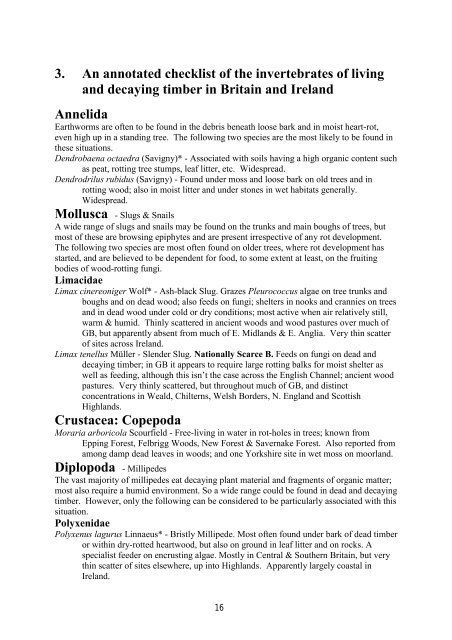Crustacea: Copepoda - Cerambycoidea.com
Crustacea: Copepoda - Cerambycoidea.com
Crustacea: Copepoda - Cerambycoidea.com
Create successful ePaper yourself
Turn your PDF publications into a flip-book with our unique Google optimized e-Paper software.
3. An annotated checklist of the invertebrates of living<br />
and decaying timber in Britain and Ireland<br />
Annelida<br />
Earthworms are often to be found in the debris beneath loose bark and in moist heart-rot,<br />
even high up in a standing tree. The following two species are the most likely to be found in<br />
these situations.<br />
Dendrobaena octaedra (Savigny)* - Associated with soils having a high organic content such<br />
as peat, rotting tree stumps, leaf litter, etc. Widespread.<br />
Dendrodrilus rubidus (Savigny) - Found under moss and loose bark on old trees and in<br />
rotting wood; also in moist litter and under stones in wet habitats generally.<br />
Widespread.<br />
Mollusca - Slugs & Snails<br />
A wide range of slugs and snails may be found on the trunks and main boughs of trees, but<br />
most of these are browsing epiphytes and are present irrespective of any rot development.<br />
The following two species are most often found on older trees, where rot development has<br />
started, and are believed to be dependent for food, to some extent at least, on the fruiting<br />
bodies of wood-rotting fungi.<br />
Limacidae<br />
Limax cinereoniger Wolf* - Ash-black Slug. Grazes Pleurococcus algae on tree trunks and<br />
boughs and on dead wood; also feeds on fungi; shelters in nooks and crannies on trees<br />
and in dead wood under cold or dry conditions; most active when air relatively still,<br />
warm & humid. Thinly scattered in ancient woods and wood pastures over much of<br />
GB, but apparently absent from much of E. Midlands & E. Anglia. Very thin scatter<br />
of sites across Ireland.<br />
Limax tenellus Müller - Slender Slug. Nationally Scarce B. Feeds on fungi on dead and<br />
decaying timber; in GB it appears to require large rotting balks for moist shelter as<br />
well as feeding, although this isn’t the case across the English Channel; ancient wood<br />
pastures. Very thinly scattered, but throughout much of GB, and distinct<br />
concentrations in Weald, Chilterns, Welsh Borders, N. England and Scottish<br />
Highlands.<br />
<strong>Crustacea</strong>: <strong>Copepoda</strong><br />
Moraria arboricola Scourfield - Free-living in water in rot-holes in trees; known from<br />
Epping Forest, Felbrigg Woods, New Forest & Savernake Forest. Also reported from<br />
among damp dead leaves in woods; and one Yorkshire site in wet moss on moorland.<br />
Diplopoda - Millipedes<br />
The vast majority of millipedes eat decaying plant material and fragments of organic matter;<br />
most also require a humid environment. So a wide range could be found in dead and decaying<br />
timber. However, only the following can be considered to be particularly associated with this<br />
situation.<br />
Polyxenidae<br />
Polyxenus lagurus Linnaeus* - Bristly Millipede. Most often found under bark of dead timber<br />
or within dry-rotted heartwood, but also on ground in leaf litter and on rocks. A<br />
specialist feeder on encrusting algae. Mostly in Central & Southern Britain, but very<br />
thin scatter of sites elsewhere, up into Highlands. Apparently largely coastal in<br />
Ireland.<br />
16

















